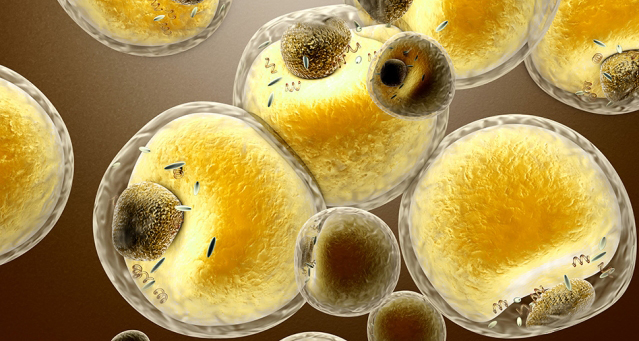It seems like cruel fate that some folks are naturally thin, while others have to work tirelessly to control their weight. But in the future, we may be able to level the playing field, because scientists have just discovered a ‘metabolic master switch’ that determines whether fat-producing adipocytes store or burn energy.
“Obesity has traditionally been seen as the result of an imbalance between the amount of food we eat and how much we exercise, but this view ignores the contribution of genetics to each individual’s metabolism,” said Manolis Kellis, a computational biologist at MIT. Kellis, however, believes that genes may be critically important. In a study published this week in the New England Journal of Medicine, Kellis and her co-authors describe a genetic variant, tightly linked to obesity, that causes adipocytes to become energy-storing white fat cells instead of energy-burning beige fat cells.
The variant in question is associated with an ‘enhancer’ intron — a non-coding region of DNA that affects the expression of two far-away genes known as IRX3 and IRX5. It’s these IRX genes that are involved in determining what kinds of fat cells your body produces.
Normally, the activity of the enhancer is repressed by the protein ARID5B. But as Kellis and her co-authors learned, about 40 per cent of Europeans and 42 per cent of Southeast Asians carry an obesity risk variant in which ARID5B can’t do its job. If this is your situation, your IRX genes are working on overdrive producing energy-storing white fat cells.
Genetic risk factors like this one are often seen as bad cards; unlucky strokes of fate that we can’t do a damn thing about. But thanks to recent advances in synthetic biology, the idea of restoring normal functionality to bunk genes isn’t so crazy anymore. In laboratory cells and mice, Kellis and her collaborators are investigating whether fat-hoarding IRX genes can be switched into the fat-burning variety. Science News details their experiments:
When researchers turned down activity of the IRX genes in human fat cells, the cells became energy-burning beige fat cells. Researchers also disrupted the IRX3 gene in fat cells of normal-weight mice. Those mice lost more than 50 per cent of their body fat, even though they ate and exercised as much as other mice did. The mice were also protected from gaining weight on a high-fat diet. Disrupting the IRX3 gene in a part of the brain called the hypothalamus, which helps control appetite, did not have the same effect. That result indicates that the white-to-beige fat switch works in fat tissue, not in the brain.
An actual treatment for humans with the genetic variant is still many years off, but it’s exciting to know that we have such a promising target in mind. As Kellis puts it, “This is perhaps the secret to curing obesity and we’re going to throw everything at it.”
Top image: Fat cells in the human body, via Shutterstock
